 Search for Flights
Search for Flights
 Search for Hotels
Search for Hotels
 Check Exchange Rates
Check Exchange Rates
 Check the Weather
Check the Weather
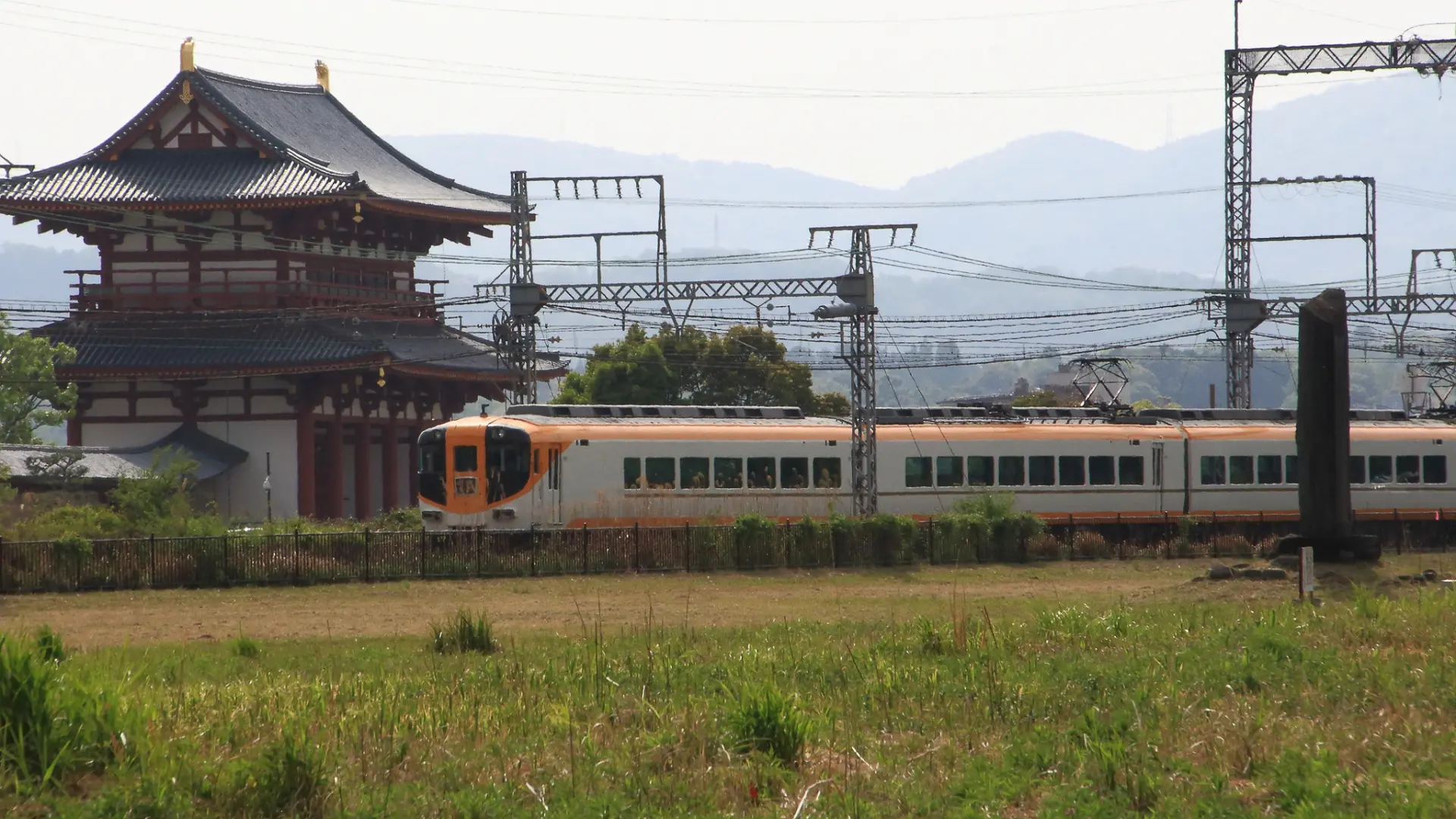
A Must-Read for Day-Trippers! Complete Guide to Getting from Kyoto to Nara
Last update
You can travel from Kyoto to Nara in under an hour, and many of Nara’s top sightseeing spots are located around the main stations—making it perfect for a day trip.
This article focuses on how to get from Kyoto Station to Nara Station, while also introducing helpful tips and must-see destinations in Nara.
If you're planning a day trip from Kyoto to Nara, this guide is a must-read.
table of contents
- Can You Visit Nara on a Day Trip from Kyoto?
- For Day Trips, Head for Kintetsu Nara Station
- Find the Fastest and Cheapest Routes! How to Get from Kyoto Station to Nara Station
- Useful Tips Before Traveling from Kyoto to Nara
- 6 Must-See Attractions When Visiting Nara
- Is Nara Closer to Kyoto or Osaka?
- Summary
Can You Visit Nara on a Day Trip from Kyoto?
Kyoto and Nara are about 40 km apart in a straight line. Depending on the transportation method, you can generally get from one to the other in under an hour.
With such convenient access, many travelers choose Nara as a day trip destination from Kyoto.
In fact, many travel websites and guidebooks feature day trip plans from Kyoto to Nara.
Most of Nara’s key attractions are located within a 1-kilometer radius of Nara Park and can be reached on foot or by bus from Kintetsu Nara Station within 10 to 20 minutes.
One of the greatest advantages of visiting Nara from Kyoto on a day trip is the chance to experience the charm of Japan’s ancient capital in a compact and time-efficient manner.
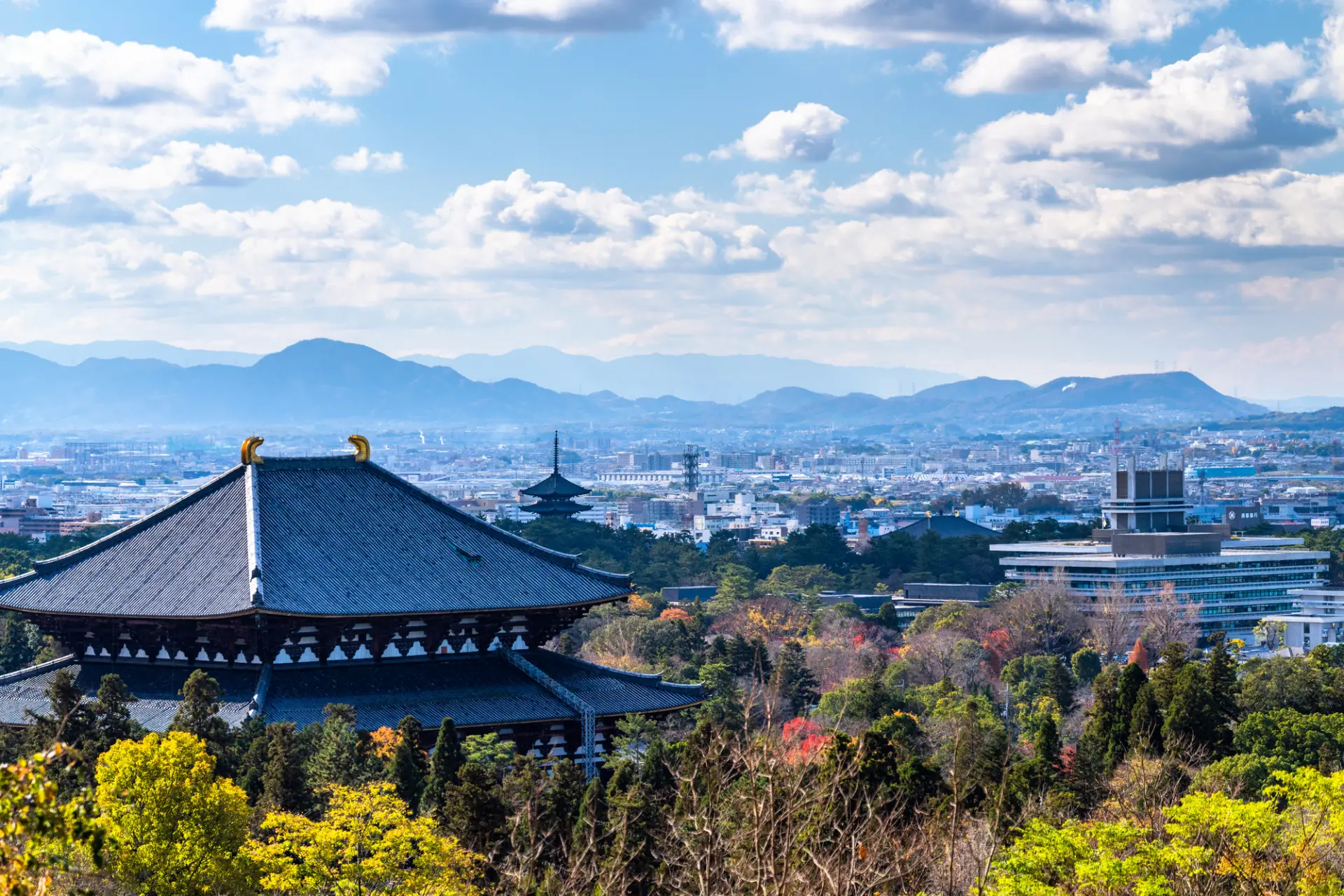
One of Nara’s charms is that major attractions are clustered near the station.
For Day Trips, Head for Kintetsu Nara Station
Nara’s two main stations are JR Nara Station, which is surrounded by accommodations and convenient for staying overnight, and Kintetsu Nara Station, which offers easier access to sightseeing areas.
Kintetsu Nara Station is about a 10-minute walk from Nara Park, making it a great starting point for visiting famous sites like Todai-ji Temple, Kofuku-ji Temple, and Kasuga Taisha Shrine.
Other UNESCO World Heritage sites such as Yakushi-ji Temple and the Nara Palace Site are also along the Kintetsu Line, allowing for easy route planning.
JR Nara Station, on the other hand, is located about 900 meters (around a 15-minute walk) from Kintetsu Nara Station and has fewer attractions nearby—which may feel less convenient, especially for first-time visitors.
If you’re planning a day trip, it’s best to start your itinerary from Kintetsu Nara Station to minimize travel time and maximize sightseeing.
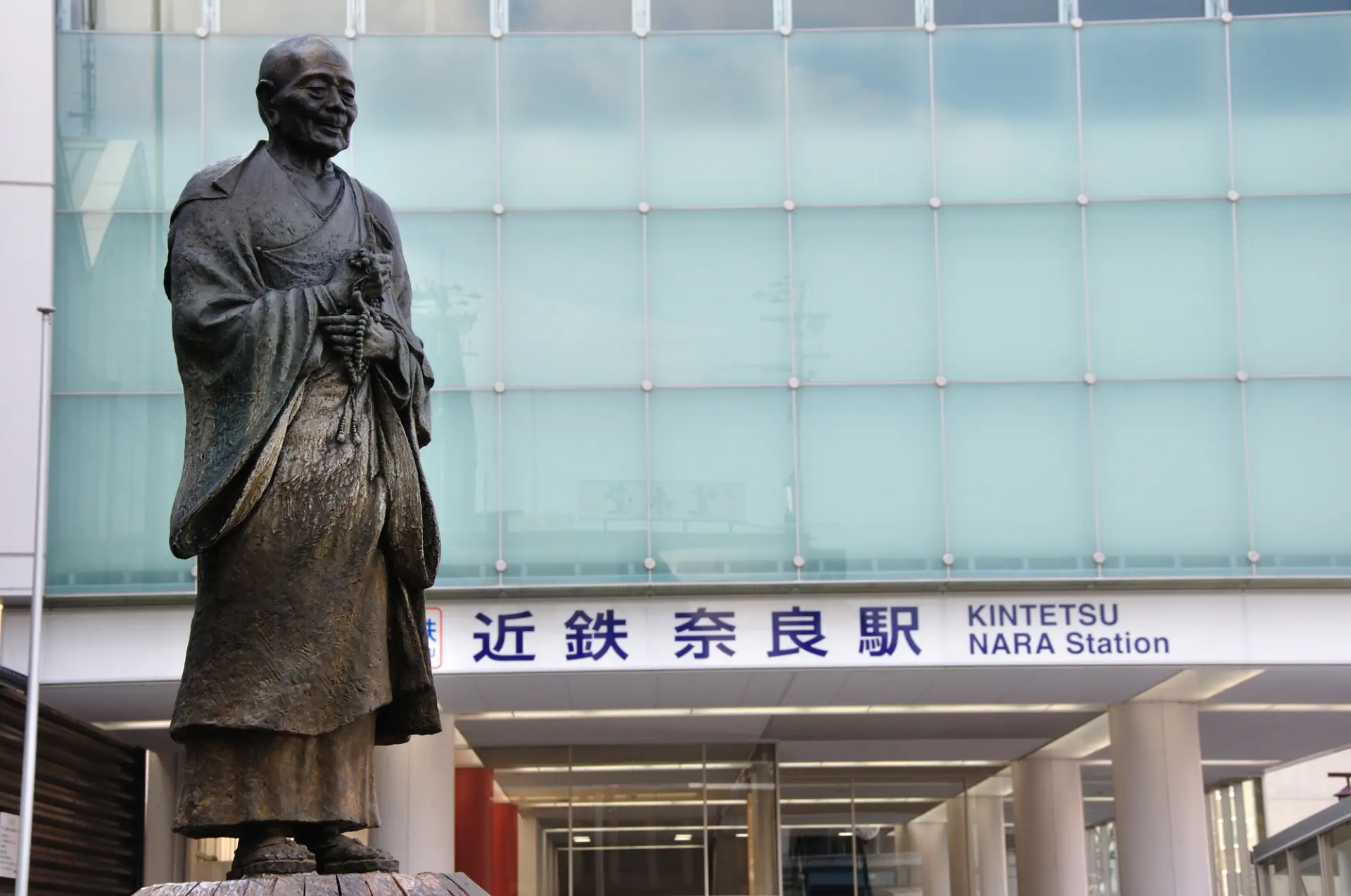
Kintetsu Nara Station serves as the starting point for Nara sightseeing.
Find the Fastest and Cheapest Routes! How to Get from Kyoto Station to Nara Station
Here, we introduce how to get from Kyoto Station to Nara Station, the starting point for many travelers.
We'll highlight both the cheapest and the fastest routes so you can choose the best option based on your travel schedule and preferences.
Fastest Route
The quickest way to get to Nara is to take a Kintetsu Limited Express from Kintetsu Kyoto Station to Kintetsu Nara Station.
However, since Limited Express trains require an additional limited express ticket and only save about 10 minutes, you may also want to consider using a Rapid Express, which only requires a base fare ticket.
Both Limited Express and Rapid Express trains run only one or two times per hour, so it’s best to check the schedule in advance when planning your trip.
- Route
- Board the Kintetsu Kyoto Line Limited Express bound for Kintetsu Nara at Kintetsu Kyoto Station, and get off at Kintetsu Nara Station
- Travel Time
- About 35 min
- One-Way Fare
- 1,280 yen (760 yen base fare + 520 yen limited express ticket)
*Information as of July 2025
Make the Most of Your Travel Time with the Sightseeing Limited Express “AONIYOSHI”
If you're traveling from Kintetsu Kyoto Station to Kintetsu Nara Station, consider riding the Sightseeing Limited Express “AONIYOSHI.”
Operated by Kintetsu Railway, AONIYOSHI connects Osaka, Nara, and Kyoto with a luxurious sightseeing experience.
The train runs daily except on Thursdays, and the trip from Kyoto to Kintetsu Nara takes about 35 minutes.
The one-way fare is 1,490 yen for a twin seat for two people (if used by one person, an extra 370 yen is required).
*Fares vary by boarding station, seat type, and number of passengers.
Designed around the concept of a “relaxing journey through history,” the train features interiors inspired by Shosoin treasures and Tenpyo pattern, offering an elegant space that lets passengers feel the ambiance of Nara the moment they step aboard.
With wide glass windows to enjoy the scenery and custom-made seating for extra comfort, AONIYOSHI turns travel time into a memorable part of your trip.
You can also purchase exclusive desserts and original merchandise on board, adding to the experience.
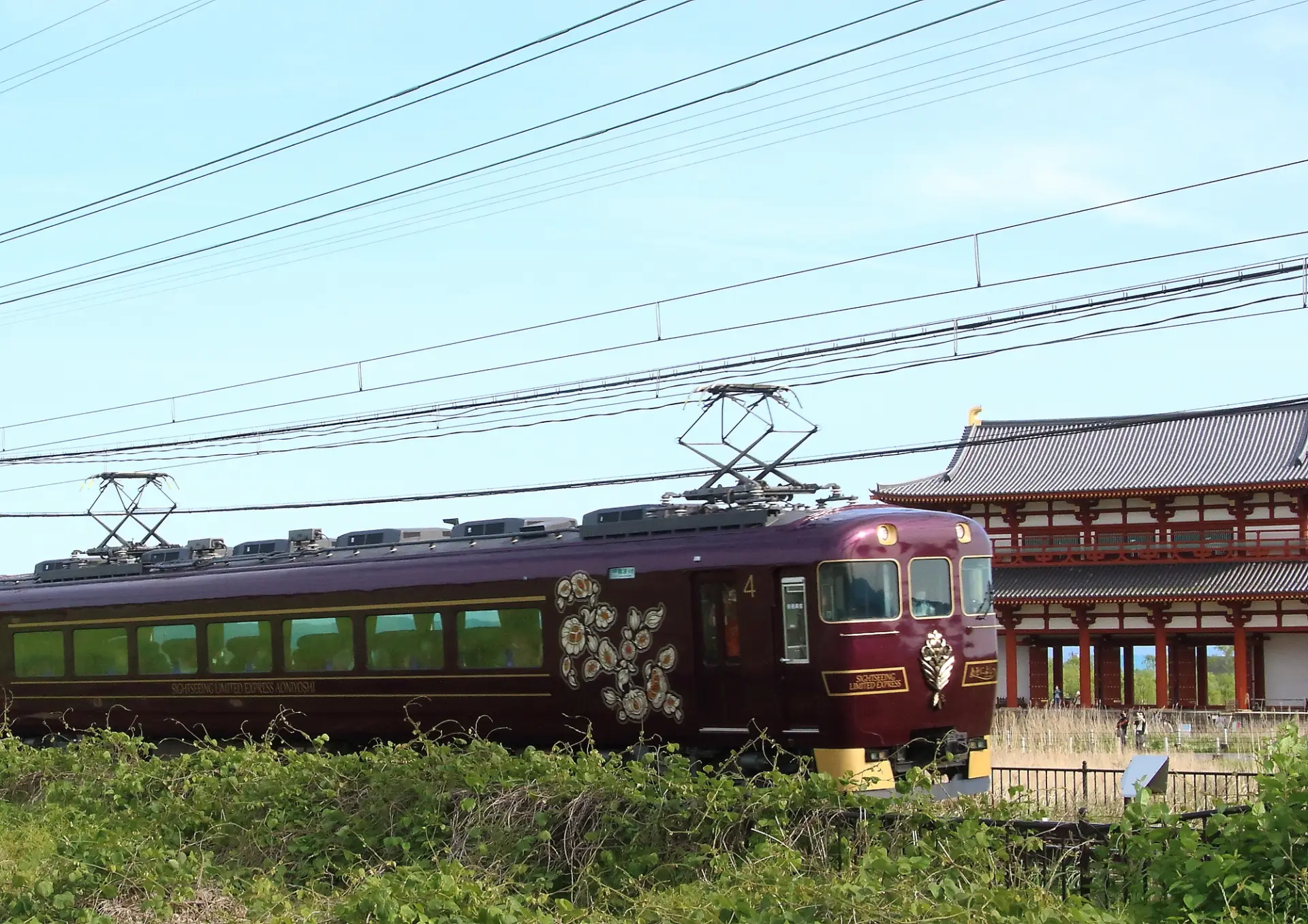
Travel from Kyoto to Nara in a refined and relaxing setting.
Cheapest Route
The most budget-friendly way to get to Nara is by taking the JR Miyakoji Rapid from JR Kyoto Station to JR Nara Station.
However, this train only runs up to twice per hour during the 9:00–17:00 time window on weekdays and weekends (typically departing at 7 and 37 minutes past the hour).
If you're traveling outside this time window, use a Rapid, Section Rapid, or Local train on the JR Nara Line instead.
While the fare remains the same, travel time increases to around 55 minutes to 1 hour and 10 minutes.
- Route
-
1. Take the JR Miyakoji Rapid bound for Nara from JR Kyoto Station and get off at JR Nara Station
2. Walk from JR Nara Station to Kintetsu Nara Station - Travel Time
- About 45 min
- One-Way Fare
- 720 yen
*Information as of July 2025
Useful Tips Before Traveling from Kyoto to Nara
Here are three useful tips to make your trip from Kyoto to Nara smoother and more economical.
Each tip can help you save time, money, and energy—so make sure to keep them in mind before your trip.
By using these tips, you’ll be able to enjoy more of your time, budget, and energy on sightseeing.
Use IC Cards for a Smooth Trip in Kyoto and Nara
IC cards such as Suica and ICOCA are highly recommended for travel in the Kyoto and Nara areas.
They can be used on Kintetsu and JR lines as well as on most local transit systems, allowing you to move around without the hassle of buying tickets every time.
Beyond public transportation, these cards are also accepted at participating convenience stores, vending machines, and even some tourist attractions—making them useful in many situations.
With just a tap of the card, the fare is automatically deducted, so you don’t need to calculate fares or handle cash.
If you don’t already have an IC card, you can buy one at station ticket machines or counters.
Additionally, if you're using Kintetsu, Hankyu, Hanshin, or Osaka Metro lines, you can also use contactless credit cards for payment.
Cards with the ripple mark (VISA, JCB, UnionPay) are accepted, and smartphones with contactless payment set up are also usable.
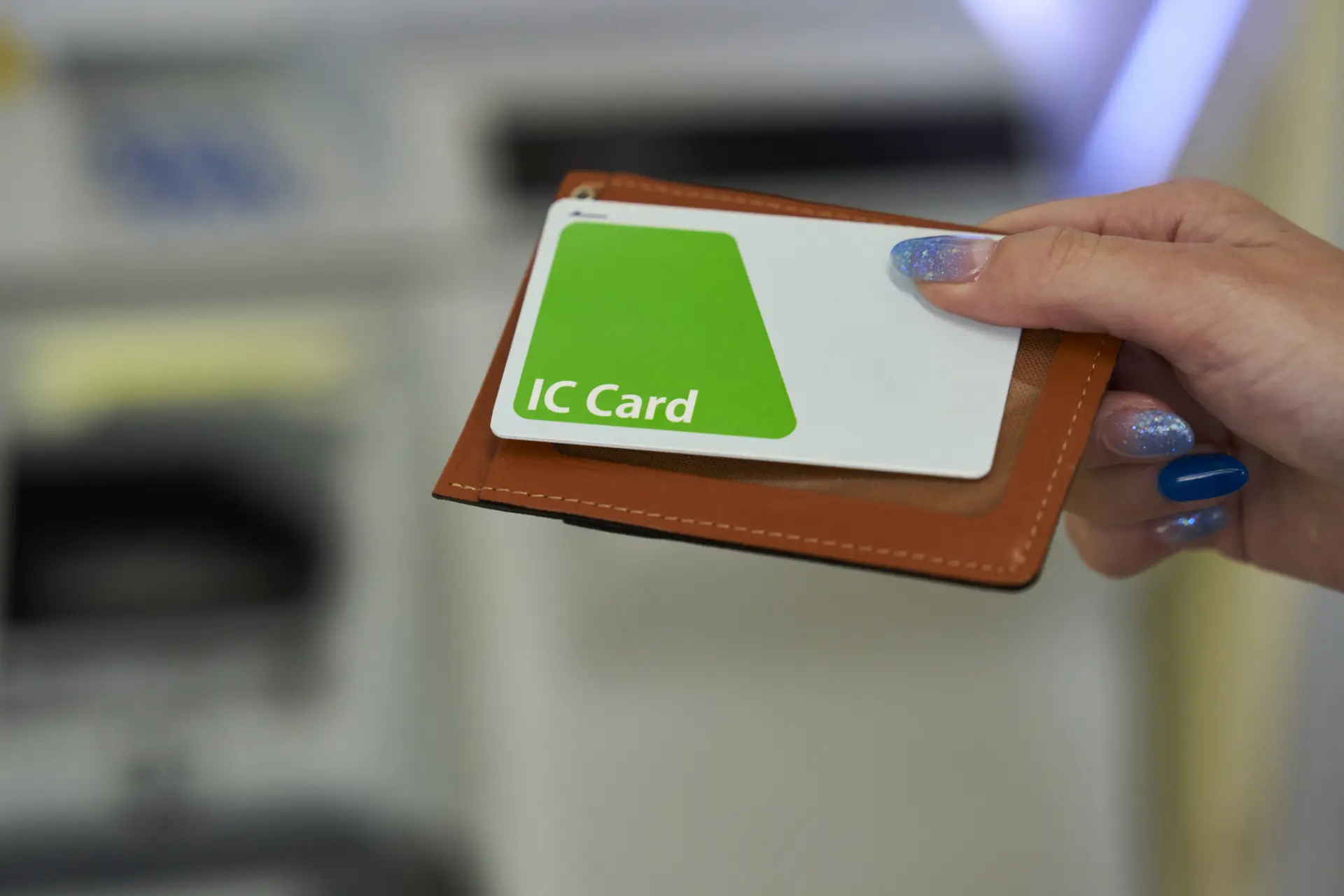
IC cards help reduce stress during travel.
Traveling Around Kansai? Consider the “KINTETSU RAIL PASS”
The KINTETSU RAIL PASS is a special discount ticket offered by Kintetsu Railway for international tourists.
There are four types depending on the area and length of use: 1-Day, 2-Day, 5-Day, and 5-Day Plus passes.
Each pass covers different areas, but all offer unlimited rides on Kintetsu lines (Limited Express rides require a separate ticket), the Iga Railway, and select Nara Kotsu and Mie Kotsu bus routes.
Not only can you travel around Osaka, Nara, Kyoto, Mie, and Nagoya conveniently and affordably, but each pass also includes discount perks at sightseeing facilities along the route.
Of course, the pass can also be used for travel from Kintetsu Kyoto Station to Kintetsu Nara Station.
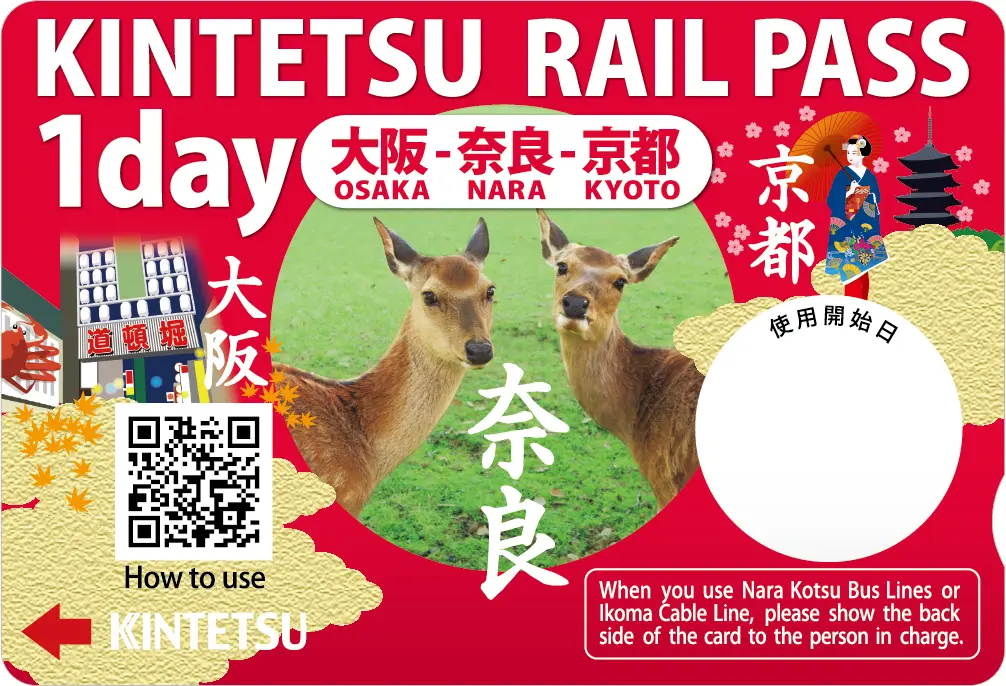
Special rail passes that can be used not only in Kyoto and Nara but also throughout the Kansai region
Avoid Crowds by Traveling Early in the Morning
As in many parts of Japan, weekday mornings and evenings in Kyoto and Nara are marked by rush-hour congestion.
Trains and stations are especially crowded during morning (7:00–9:00) and evening (18:00–19:00) rush hours, making it harder to move around.
Traveling in such crowded conditions can be more exhausting than expected.
Daytime hours (departing Kyoto between 10:00 and 12:00, returning from Nara between 15:00 and 17:00) are also busy with tourists, but generally less intense than rush hours.
However, on weekends, holidays, and during the spring and autumn sightseeing seasons, trains can be packed even during midday and early evening. To travel more comfortably, we recommend departing Kyoto early in the morning.
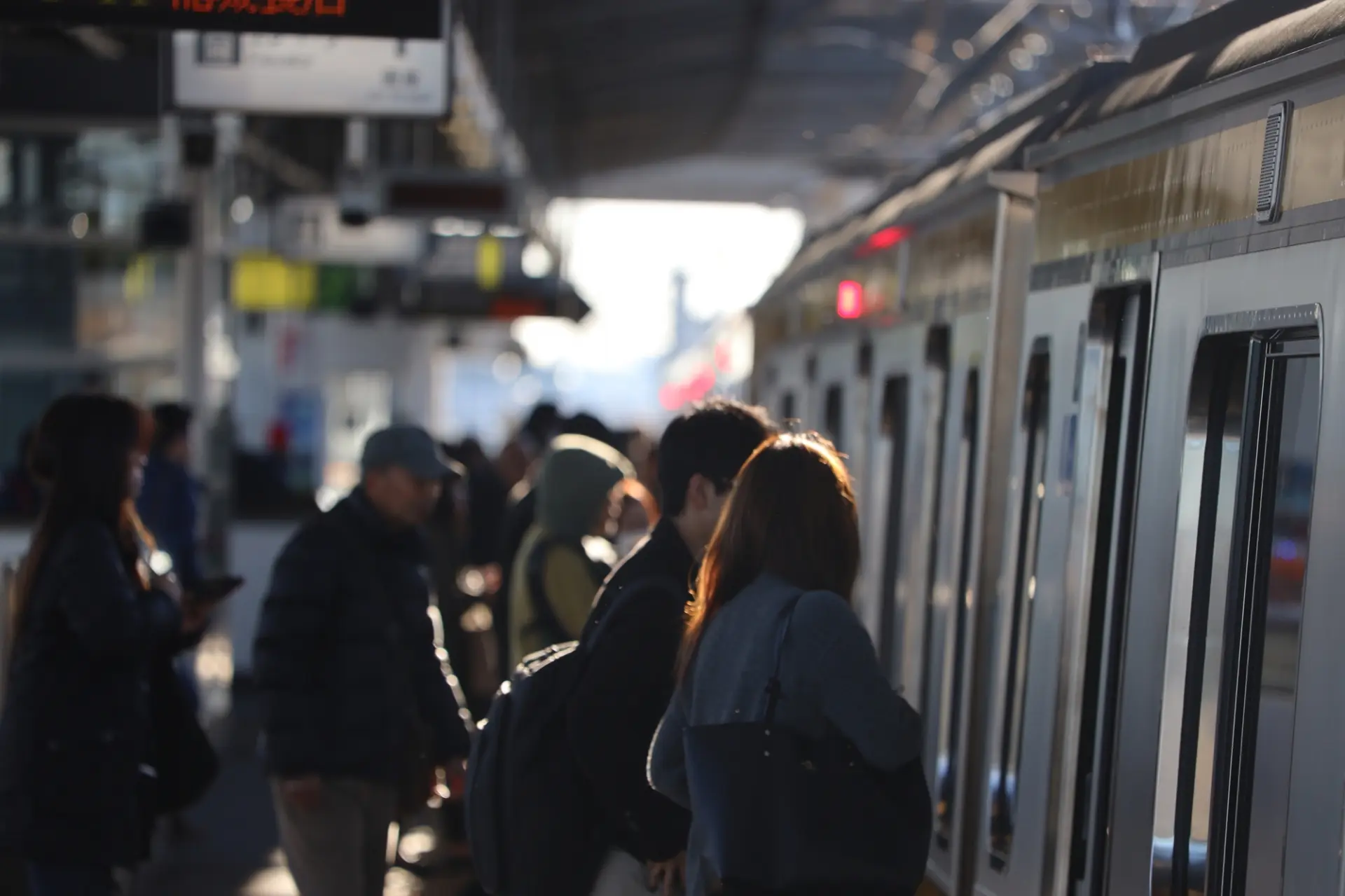
Avoid crowded hours to reduce travel fatigue.
6 Must-See Attractions When Visiting Nara
Here are six of Nara’s top sightseeing spots that showcase the city’s unique charm.
Many of these locations are part of the UNESCO World Heritage listing “Historic Monuments of Ancient Nara,” and all are essential stops on any Nara itinerary.
Each is easily accessible from JR Nara Station or Kintetsu Nara Station and can be visited within a short amount of time.
1. Nara Park
Covering a vast 5.11 km², Nara Park features a beautiful landscape where historic buildings blend harmoniously with nature.
It’s home to Nara’s most iconic attractions, such as Todai-ji Temple, with its Great Buddha, and Kasuga Taisha Shrine, a place of worship for centuries.
Seasonal beauty is also a major draw, with cherry blossoms in spring and vivid foliage in autumn.
Another highlight is the approximately 1,300 free-roaming deer, considered sacred messengers of the gods at Kasuga Taisha.
Buy some deer crackers and enjoy walking among these gentle creatures.
The park is only about a 10-minute walk from Kintetsu Nara Station.
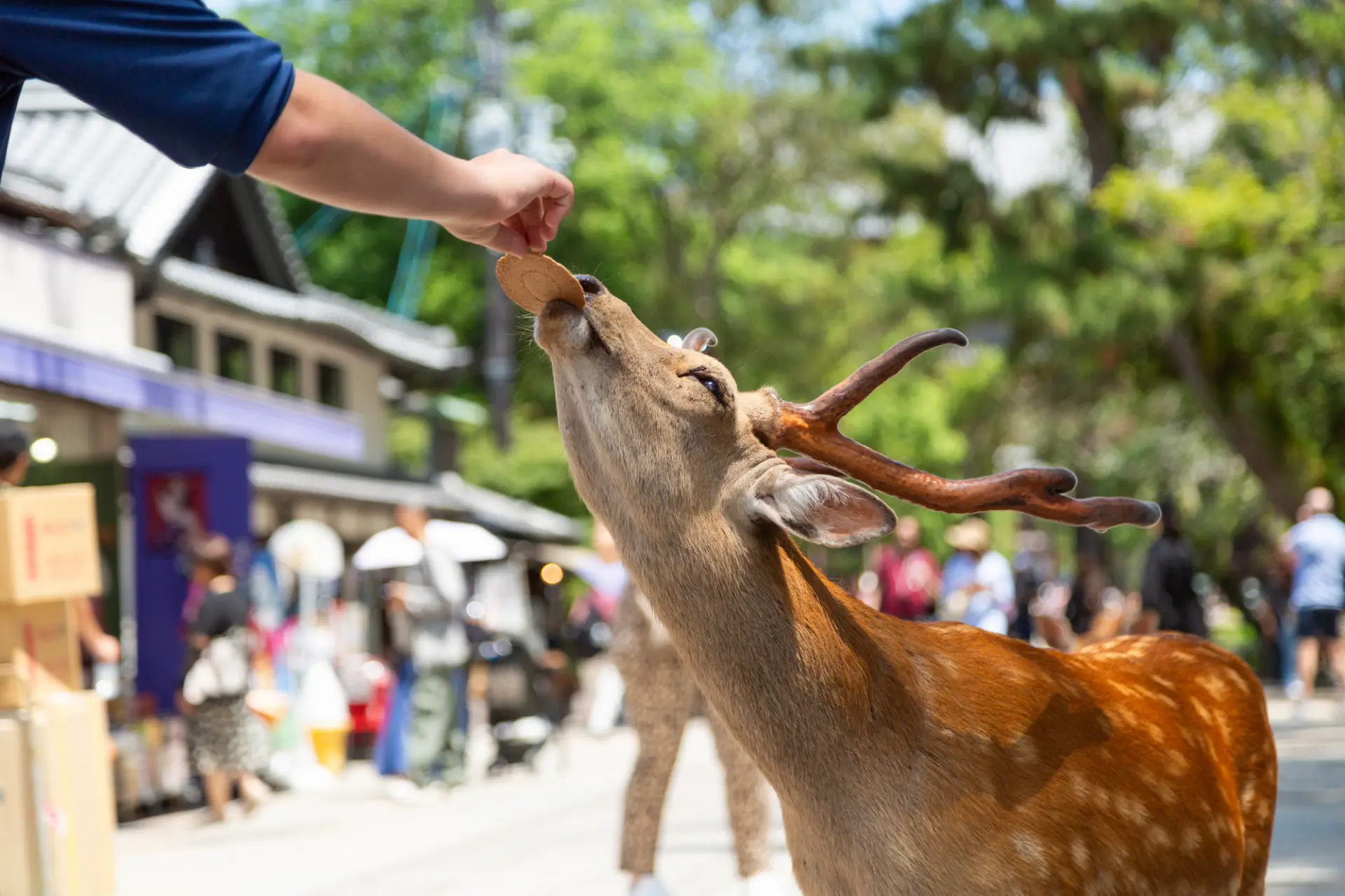
Interacting with deer is one of the highlights of Nara Park.
2. Todai-ji Temple
Standing at the heart of Nara Park, Todai-ji Temple is one of Nara’s most famous temples.
Its main hall, the Great Buddha Hall, is one of the world’s largest wooden structures, and houses a 15-meter-tall statue of Vairocana Buddha—known as the Great Buddha of Nara.
You’ll be struck by the hall’s immense scale and the intricacy of the statue’s expression.
Within the temple grounds, you’ll also find the Nandaimon guarded by fierce guardian statues, and Nigatsudo Hall, famous for the Omizutori ritual.
With numerous National Treasures and Important Cultural Properties, Todai-ji Temple is a showcase of architectural and spiritual beauty from the Heian and Kamakura periods.
To get there, take a city loop bus from either JR Nara Station or Kintetsu Nara Station and get off at the “Todaiji-daibutsuden, Kasugataisha-mae” stop. The temple is about a 5-minute walk from the bus stop.
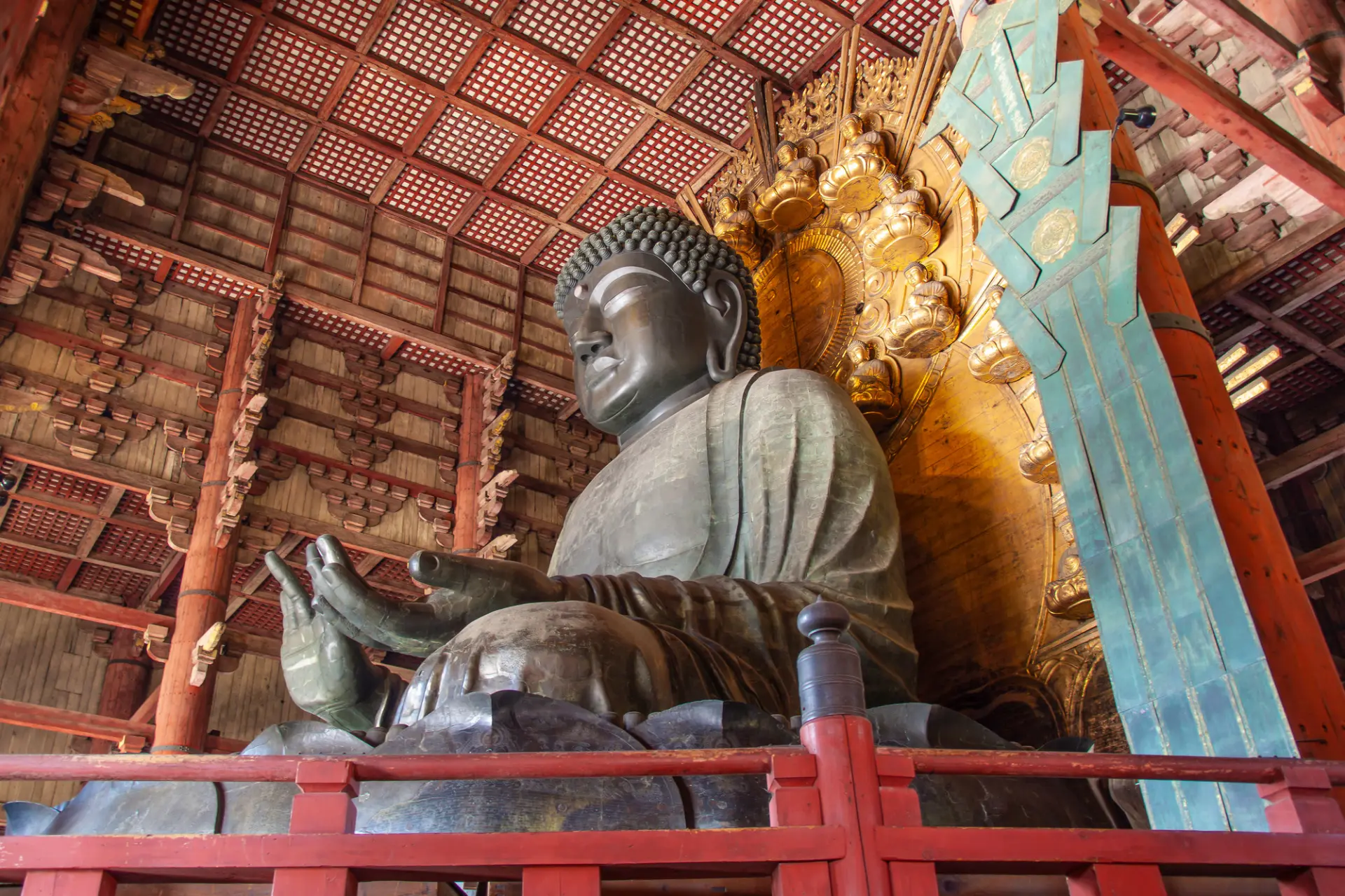
The Vairocana Buddha statue symbolizes Todai-ji Temple.
3. Kasuga Taisha Shrine
With over 1,200 years of history, Kasuga Taisha is a Shinto shrine known for its bright vermillion buildings and sacred atmosphere.
Its unique tradition of “Shikinen Zotai,” or periodic rebuilding every 20 years, preserves its original form.
One of the shrine’s highlights is the collection of roughly 3,000 bronze and stone lanterns donated over the centuries.
During the Lantern Festivals in February and August, these lanterns are all lit, casting a magical glow along the pathways.
Access: From JR Nara Station or Kintetsu Nara Station, take the Nara Kotsu Bus bound for Kasuga Taisha Honden and get off at the final stop.
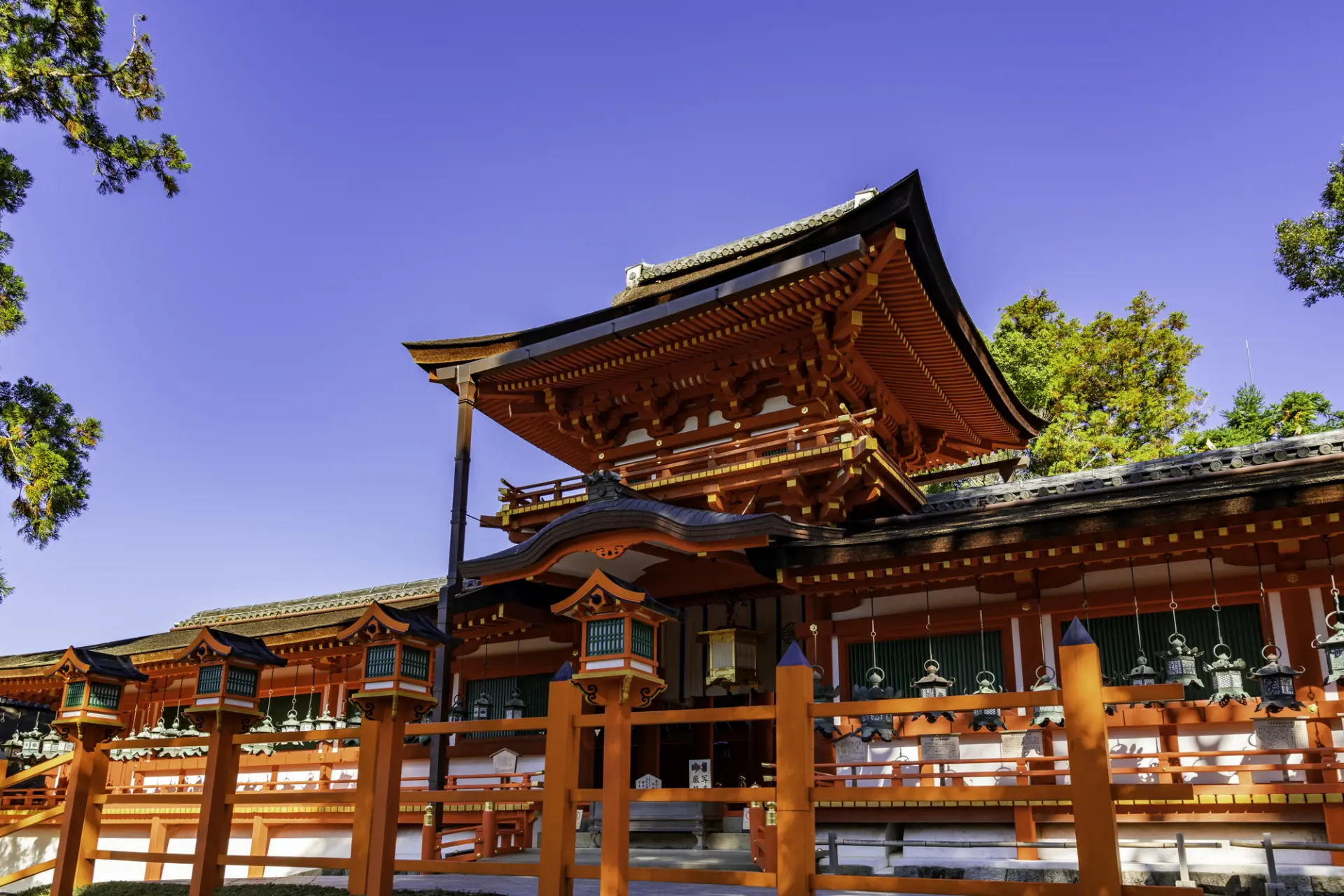
Kasuga Taisha Shrine is known for its beautiful vermillion-colored buildings.
4. Kofuku-ji Temple
Located on the edge of Nara Park, Kofuku-ji is an ancient temple founded in 710.
Its five-story pagoda, a National Treasure standing about 50 meters tall, is one of Nara’s most recognizable symbols.
In spring and autumn, the pagoda is bathed in gentle light, and its vermillion hue contrasts beautifully with blue skies and colorful foliage.
Be sure to visit the Central Golden Hall, rebuilt in 2018 after more than 300 years.
Also not to be missed is the National Treasure Hall, which houses a wealth of Important Cultural Properties and Buddhist statues—including the famous Ashura, a masterpiece of Tenpyo-period art.
The temple is conveniently located about a 5-minute walk from Kintetsu Nara Station.
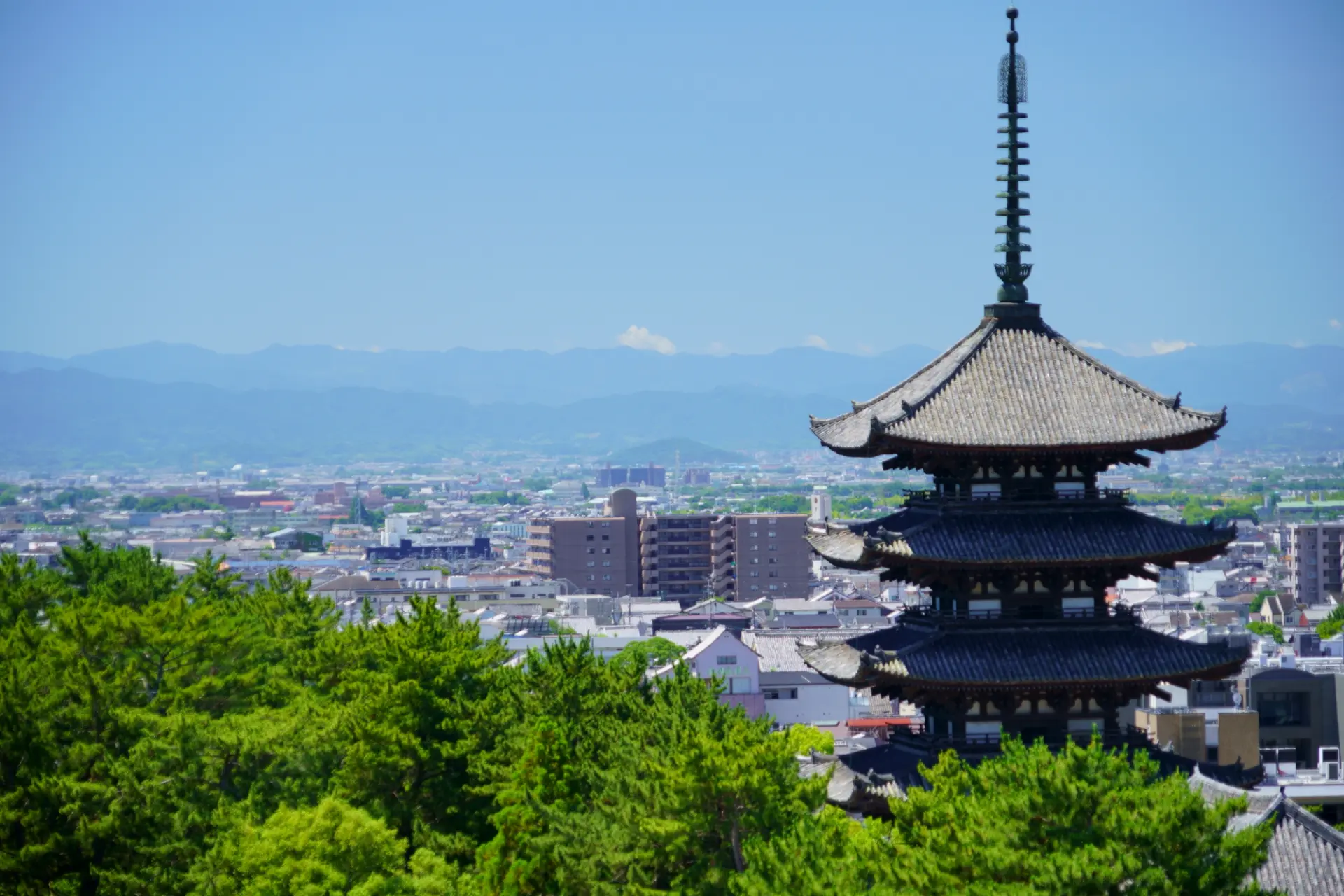
The five-story pagoda of Kofuku-ji Temple is a designated National Treasure.
5. Toshodai-ji Temple
Toshodai-ji Temple is the head temple of the Ritsu sect, founded by the Chinese monk Ganjin.
Its main hall (Kondo), built in the Nara period (710–794), is the only surviving example of a golden hall from that era and is a National Treasure.
The temple grounds are filled with many other historically significant structures designated as National Treasures and Important Cultural Properties.
The solemn atmosphere of Tenpyo culture still lingers here, offering visitors a tranquil and meditative experience.
To reach the temple, take a Nara Kotsu Bus bound for the Nara Prefectural General Medical Center from either JR Nara Station or Kintetsu Nara Station, and get off at the “Toshodai-ji” stop. The temple is just a 1-minute walk from there.
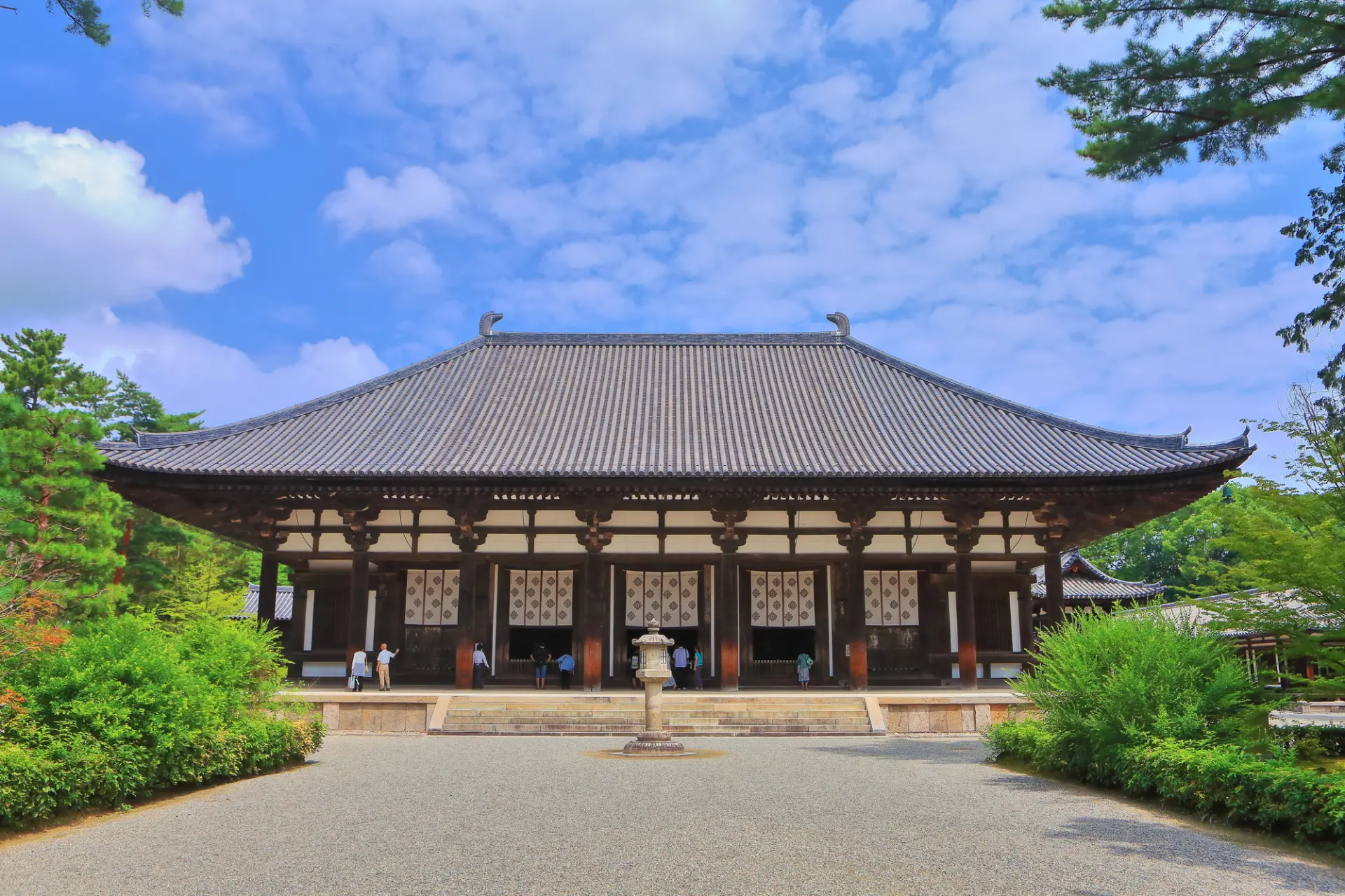
The Golden Hall at Toshodai-ji Temple is a surviving structure from the Nara period.
6. Naramachi
Naramachi is a charming district that preserves the historic townscape of the Edo (1603–1868) and Meiji (1868–1912) periods.
Traditional machiya townhouses, temples, and stone-paved alleys create a photogenic setting where you’ll feel as if you’ve stepped back in time.
The area is also dotted with cafés and galleries housed in renovated old homes, as well as workshops specializing in traditional crafts—perfect for combining sightseeing, shopping, and local treats.
You can reach Naramachi with a 10- to 15-minute walk from Kintetsu Nara Station.
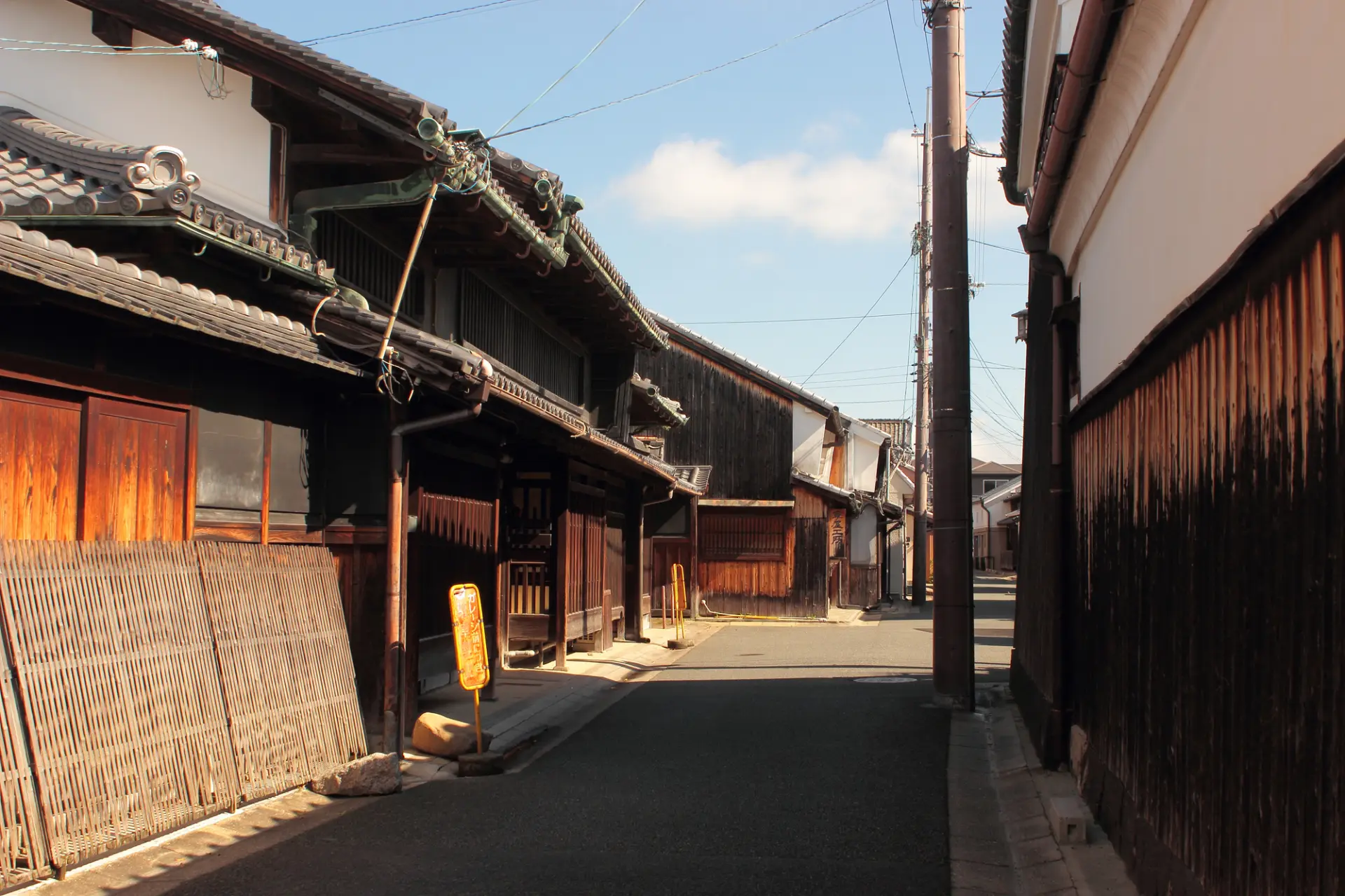
Stroll through the historic streetscape of Naramachi.
Is Nara Closer to Kyoto or Osaka?
Nara is conveniently located near both Kyoto and Osaka, with direct train access from the major stations in each city.
As shown below, both cities are close enough for a day trip, and travel times are almost the same.
If your schedule and budget allow, it’s possible to visit all three prefectures in one trip.
In that case, using Osaka—home to Kansai International Airport—as your travel base is recommended.
Distance Between Kyoto and Nara
- Distance
- 40–45 km
- Travel Time
- About 45 min (Kyoto Station – Nara Station)
- One-Way Fare
- 720 yen (using JR)
*Information as of July 2025
Distance Between Osaka and Nara
- Distance
- 45–50 km
- Travel Time
- About 50 min (Osaka Station – Nara Station)
- One-Way Fare
- 840 yen (using JR)
*Information as of July 2025
Summary
This article has provided a complete guide for travelers planning a day trip from Kyoto to Nara.
Travel time from Kyoto to Nara is less than an hour in most cases.
Take advantage of the easy access to explore Nara, a former capital rich in historical architecture and cultural heritage.
Check also...
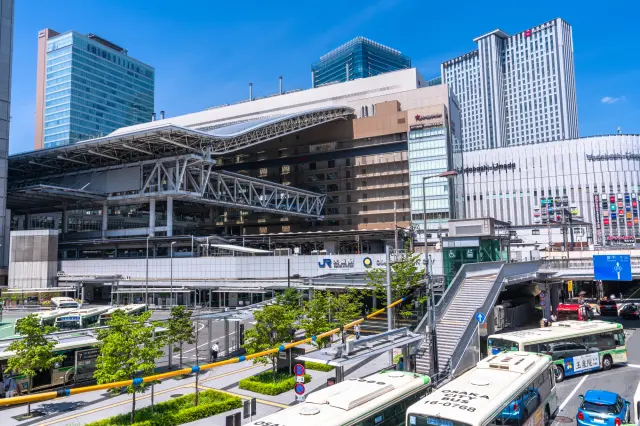
A Complete Area-by-Area Guide to Getting from Kyoto to Osaka
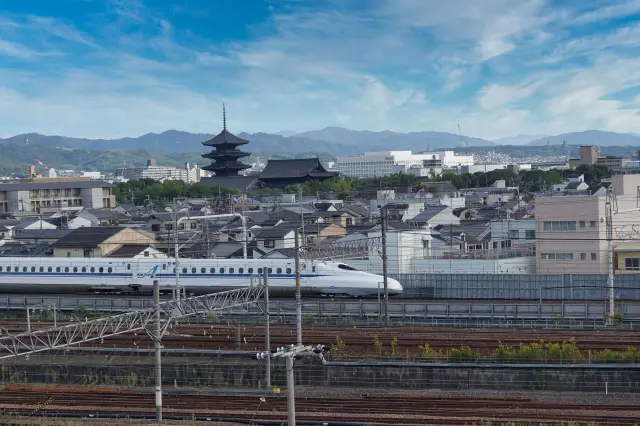
Find the Best Way to Travel! A Guide to Getting from Tokyo to Kyoto
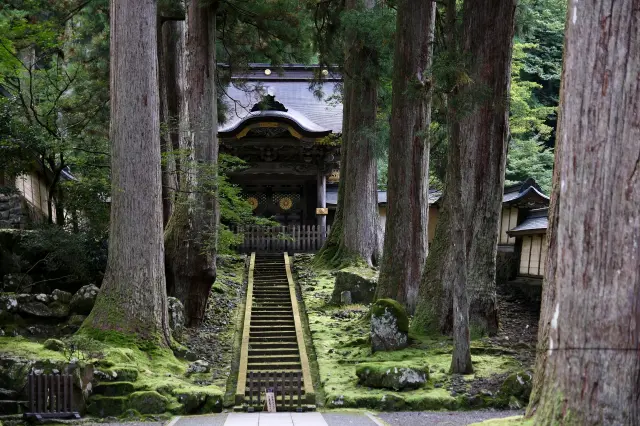
3-Day Central Japan Itinerary: From Kyoto to Fukui’s Castle Towns and Temples
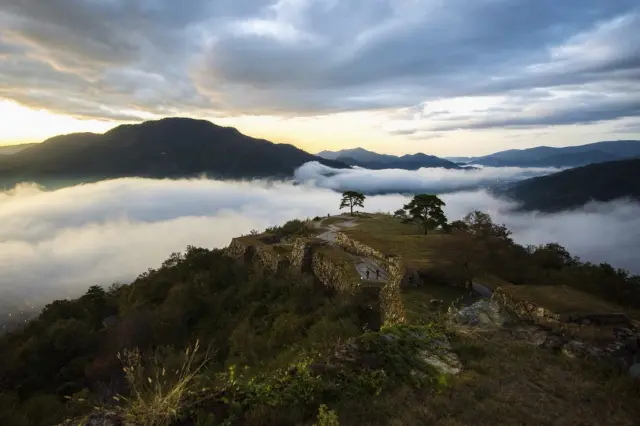
From Himeji to the Castle in the Sky: Exploring Kansai’s Hidden Castle Towns
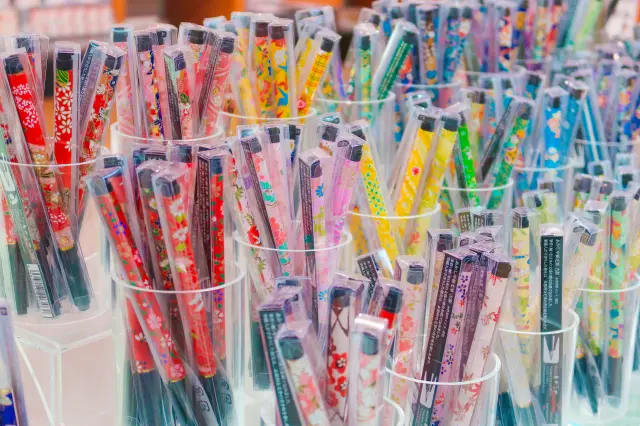
5 Local Experiences Not Found in Guidebooks: Nara Edition
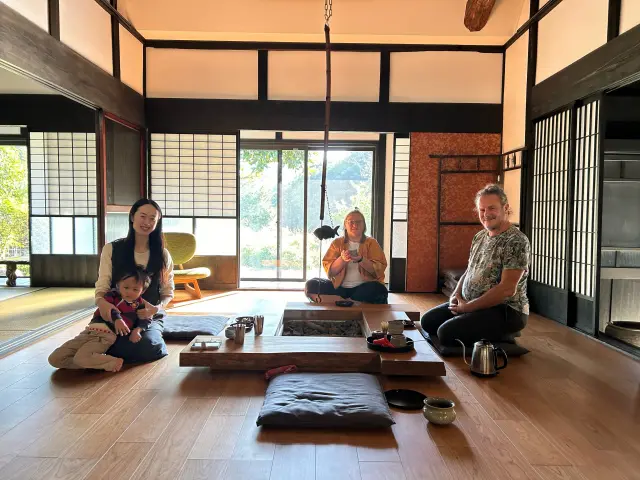
5 Local Experiences Not Found in Guidebooks: Kyoto Prefecture Edition
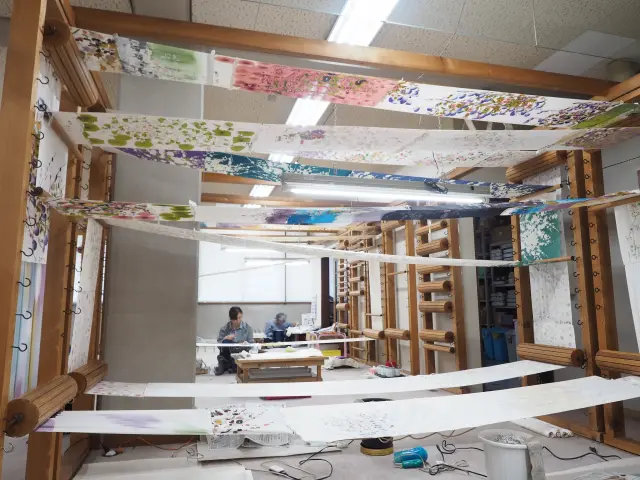
5 Local Experiences That Go Beyond the Classics: Kyoto City Edition

